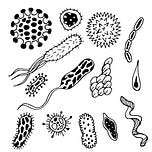It’s almost August. Some of your plants are starting to struggle, and some are thriving. Why? You prepped the soil and gave them plenty of fertilizer according to the soil tests you took back in March. You think to yourself, “They should be fine.” And then a lightbulb goes on. “I wonder if the plants are actually getting the right amount of nutrients that they need? Can I test for that? How do I do that? And what do I do about it?” Let’s discuss that in today’s episode.
Welcome to the Probiotics Heal The World Podcast. I’m your host, Eric Lancaster.
Intro Music: (ARTIST) PALA: (SONG)ANDROMEDA
Break: Number 2 Organics
2nd Break: Artist: Cast of Characters. Song: Strike, Spare Time
Outro: Artist: Thor. Song: Djoker
Ok. We have discussed nutrients, including macronutrients like NPK and micronutrients like selenium, copper, magnesium, and boron. Plants, like us, need nutrients to grow. And, like us, they show signs when they are getting sick. Learning to pick up on those signs and determine what is going on is a bit of an art without testing. Environmental issues such as heat stress and pest pressure can resemble nutrient deficiency. Let’s look at some of the most common types of nutrient deficiencies.
Chlorosis is the yellowing of the leaves, typically starting from the older leaves and spreading to younger ones. It is a common symptom of deficiencies in nutrients such as nitrogen (pale yellow), iron (yellow with green veins), magnesium (yellow between veins), and manganese (yellow with small brown spots).
Necrosis refers to the death of plant tissue, often as brown or black spots on leaves or other plant parts. Calcium and potassium deficiencies can cause necrosis in various plant tissues.
Stunted Growth- Insufficient nitrogen, phosphorus, and potassium can lead to reduced growth and smaller plant size.
Poor Flower or Fruit Development. Deficiencies in phosphorus and potassium can result in reduced flower and fruit production.
Leaf Deformities- Some nutrient deficiencies, like excess boron and too little zinc or nickel, can cause leaves to be misshapen or abnormal growth patterns.
Red or Purple Coloration- Phosphorus deficiency can cause a reddish-purple coloration in leaves and stems.
Brittle or Damaged Leaves- Calcium deficiency can lead to weak cell walls and brittle and damaged leaves.
Wilting- Nutrient deficiencies can sometimes cause plants to wilt, even when adequately watered. If there is adequate water, these could be signs of low Boron, Calcium, Magnesium, and/or Potassium.
Delayed Maturity- Plants deficient in essential nutrients, including K, mg, N, P, and S, may take longer to reach maturity.
The only way to know what it is is to sample the plant and see what the plants are getting regarding nutrients. There are a couple of ways to do this. One is called a plant tissue analysis, and the other is the SAP analysis. Both are done multiple times per season to track the performance of the plants, allowing farmers to make adjustments throughout the growing season.
After your test results return, identify the deficiencies accurately before taking corrective measures. Conducting a soil test or consulting with a gardening expert can help determine nutrient imbalances and guide you in correcting them effectively. Sometimes for an extra fee, labs will also give nutrient recommendations according to the crop being grown.
Here are some common ways to correct nutrient deficiencies in plants:
Fertilization: The most common method to correct nutrient deficiencies is through fertilization. Depending on the nutrients that are lacking in the soil, you can use different types of fertilizers to supply the required nutrients. For example:
Nitrogen deficiency: Use nitrogen fertilizers (e.g., ammonium nitrate, urea).
Phosphorus deficiency: Use fertilizers containing phosphorus (e.g., triple superphosphate).
Potassium deficiency: Use fertilizers containing potassium (e.g., potassium chloride, potassium sulfate, sulfate of potash, etc.).
Micronutrient deficiencies: Use fertilizers with chelated micronutrients (e.g., iron chelates, zinc chelates).
Organic Amendments: Incorporating organic matter into the soil, such as compost, well-rotted manure, or leaf mulch, can improve nutrient availability and help correct mild nutrient deficiencies. Aside from microbes, compost can usually offer 3 to 5 lbs of N, P, and K per ton applied. It is difficult to apply compost during the growing season to field crops that don’t allow for vehicles in the field. However, it can be broadcast in pellet form or dried in a field. It is easier to hand spread around plants for gardens, orchards, and vineyards.
pH Adjustment: Soil pH can affect nutrient availability. If the soil pH is too high or too low, it can lead to nutrient deficiencies. Adjusting the pH to the appropriate range can help improve nutrient uptake. If it is too high, sulfur is usually added. If it is too low, lime is commonly applied (keep in mind, lime takes time to make pH adjustments unless it is a highly available lime). I might add that microbes can make pH adjustments as well when applied at high rates. My experiences with activated EM were sometimes amazing, where we saw soil pH from a range of 8.3 to 8.5 drop one-half to 3/4 of a point in one application and stay there into the next season! Likewise, I have seen it increase the same amount in acidic soil.
Foliar Sprays: In some cases, especially for micronutrient deficiencies, foliar sprays can supply nutrients directly to the leaves. This method allows the plant to absorb the required nutrients quickly. Foliar sprays can also benefit from raising the brix (sugar content) of the plant, making it more pest-resistant.
Proper Irrigation: Providing consistent and adequate water to plants can optimize nutrient uptake and reduce the risk of water-related nutrient deficiencies. Irrigation can also be used to cool the plants during intense summer heat.
Remember that nutrient imbalances from excessive fertilization can be just as hazardous as nutrient deficiencies. Sticking to suggested application rates and avoiding using too much fertilizer is essential.
Additionally, the soil type and other environmental conditions may impact the availability of specific nutrients. To create a successful nutrient management plan, it is vital to consider the individual requirements of the plants and the soil conditions.
Consider consulting with a local agricultural extension agency or qualified horticulture professional who can offer recommendations based on your soil and plant species for a more precise and customized approach.
{Music fades out] (ARTIST) ALSEVER LAKE:(SONG) NOBODY KNOWS








Share this post